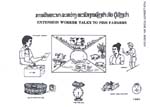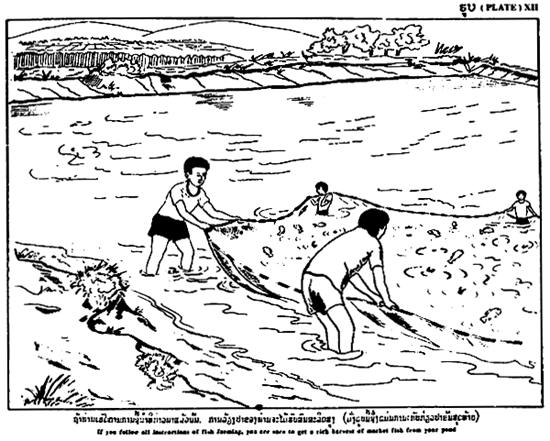

EXTENSION WORKER TALKS TO FISH FARMERS
 |
 EXTENSION WORKER TALKS TO FISH FARMERS |

DEPARTMENT OF LIVESTOCK - FAO / UNDP PROJECT
LAO / 82 / 014
VIENTIANE: OCTOBER, 1987


This extension handbook on fish culture is written in a simple style and presented as “Extension Worker Talks to Fish Farmers”. Thus the coverage of the topic is more narrative in telling the scientific knowledge to the farmers and to make it an interesting and light reading for them. The farmers are encouraged to raise questions and doubts in an attempt to create overall awareness and interest in them in fish farming. Also, the extension worker is guided in adopting an humble attitude while approaching the farmers and with a proper understanding of their psychology and also knowing well the limitations in propagating new technologies.
It is expected that the present effort in popular Lao language will fulfil the much needed extension objectives through a dialogue between the extensionist and the farmers.
The Applied Research Consultant and former Coordinator of the project Dr. Hiralal Chaudhuri provided valuable suggestions and figures for incorporation in the handbook which are gratefully acknowledged. The Chief Counterpart Officer, Mr. Khampheth Roger helped in editing part of the Lao text and Mr. Southsavath Thammavongsa, Senior Assistant in redrawing some of the figures.
LAO PDR is land-locked country (Fig. 1), area 236,800 sq. km, estimated population 3.8 million (1983). Its main aquatic resources for fishery development are approximately 1800 km stretch of River Mekong shared by Thailand for most of its length in Laos plus its tributaries and other minor rivers and streams; about 57,000 ha of reservoirs and lakes; over 5000 ha of fish ponds; and about 6000 ha of bunded rice fields in addition to swamps which can be reclaimed for fish culture.
In Laos ‘fish’ seems to be most closely associated to ‘water’ and almost all waters are expected to have fish except the drinking water supply which in local language is called ‘NAM PA PA’ (the water having no fish). The popular Lao saying goes, ‘where is water, there is fish and where is field, there is rice’.
LAO people like fish very much and it is also easy to grow fish throughout the country. Fish protein is a highly valuable animal protein, easily digestible and extremely delicious.
The capture fishery resources are mainly the rivers (Mekong being the main one), and the resevoirs and lakes. These fishery resources are being exploited at present without any well organized management programme and have already started showing decline in fish catches.
Among the culture resources, the most potential resource is that of fish ponds which are scattered all over the country and it can also include small reservoirs or impoundments of 5–10 ha as found even in some hilly parts of the country. The swamps and rice fields can also be brought under fish culture, if the swamps are reclaimed and the rice fields are well managed.
The national priority in animal protein production is very high to meet the protein deficiency of the rural population. One of the cheapest source of such protein production is through fish culture. The resource of fish ponds is still lying mostly unutilized or under-utilized, and if this activity is simply integrated with livestock and crop production systems, the efficiency and economics of fish culture are greatly improved. The waste products of livestock (cattle pig poultry ducks) and by-products of agricultural crops (rice bran/oil cakes spoiled cereals, etc.) can be profitably utilized in pond fish production system for which suitable technologies have already been developed and demonstrated in Laos.
While the technology of integrated fish culture is well developed, but there is urgent need for this technology to reach to farmers located in remote villages. So it is essential that an efficient well-organized fish culture extension service is developed in the country, which is almost non-existent at present mainly due to acute shortage of qualified manpower, funds and difficult road communication system. Though it will take time to remove the above stated constraints, a beginning has to be made in easily accessible villages and cooperatives with the available limited manpower and financial resources, and these will have to serve as satellite demonstration centres for neighbouring areas and thus the impact of fish culture technology would gradually spread to remote areas of the country. Under the present limitations of manpower situation, it is considered important that the existing extension services of agriculture, cooperatives, livestock and fisheries should maintain close link with each other and the entire pool of extension manpower is given exposure to the related fields as mentioned above.
Now a word on approach of the extension worker towards the farmers which is a highly significant point and it decides the reaction of the farmers towards any new ideas on improved technologies. The “farmer” in general looks simple, ignorant of scientific advancements and technical terms, but infact is highly experienced - quite often even more than the extensionists and is also very cautious and intelligent in testing new technologies. So the extension worker must reach the farmer in a manner that the former can win the confidence and good will of the latter. The safest and best way to convince and interest the farmer in new improved technologies is to demonstrate the technology in a selected area. Also, in the process the extension worker shall learn about the specific problems in applying the improved technology. Thus extensionist is essentially a learner not a teacher, he has to win the confidence of the farmer. He has also to explore all possibilities to encourage and assist the farmer in obtaining essential inputs at reasonable subsidized rates through the governmental organizations, not merely advising him. However, he should promise to farmers only what he is sure of.
In case the extension worker approaches the farmer with full dedication towards his mission. self-confidence and humble approach to learn operation of developmental programmes in rural areas. he is sure to succeed and he shall even modify and improve the technology in a practical way for the benefit of the farmers. This alone would fulfil the farmers' ambitions and expectations!
In the following account an attempt has been made to bring about a dialogue between the extension worker and farmers on fish culture, with emphasis on possible doubts and lack of interest in the farmers' minds in adopting something new and different and later to slowly educate the farmers with the essentials of the concept of this new field of POND FISH CULTURE.
Hyperlinks to non-FAO Internet sites do not imply any official endorsement of or responsibility for the opinions, ideas, data or products presented at these locations, or guarantee the validity of the information provided. The sole purpose of links to non-FAO sites is to indicate further information available on related topics.
This electronic document has been scanned using optical character recognition (OCR) software. FAO declines all responsibility for any discrepancies that may exist between the present document and its original printed version.
CHAPTER I : Extension worker's FIRST VISIT to Farmers
- Explains purpose of the visit and gives a general talk; followed by
general questions from the farmers and replies by the extension worker.
- Selection of some demonstration areas for fish culture
(different types of water bodies, small/big; perennial/seasonal).
CHAPTER II : Extension worker's SECOND VISIT to the farmers
- Setting up of a demonstration programme for fish culture to show the contrast between scientific & traditional culture systems.
CHAPTER III : Extension worker's THIRD VISIT to the farmers
- Organization of a training programme for village-level extensionists.
- Educate the farmers village extensionists about the main technical
programme for fish culture in villages/cooperatives.
CHAPTER IV : Extension worker's FOURTH VISIT to the farmers
- Final evaluation of the demonstration & training programmes.
- Advice on future regular contact with the governmental authorities.
- Says “Good Bye” to move to other areas.